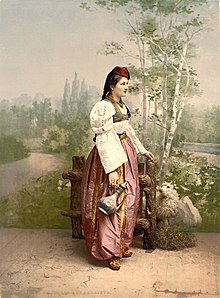
Back المرأة في البوسنة والهرسك Arabic Žene u Bosni i Hercegovini BS Dones a Bòsnia i Hercegovina Catalan ქალები ბოსნია და ჰერცეგოვინაში KA Жените во Босна и Херцеговина MK ബോസ്നിയ & ഹെർസെഗോവിനയിലെ സ്ത്രീകൾ Malayalam بوسنیا تے ہرزیگووینا وچ عورتاں PNB Жінки у Боснії та Герцеговині Ukrainian بوسنیا و ہرزیگووینا میں خواتین UR Bosniya va Gersogovina ayollari UZ
 Girl of Sarajevo, cca. 1890 – 1900 | |
| General Statistics | |
|---|---|
| Maternal mortality (per 100,000) | 11 (2015) |
| Women in parliament | 19.3% (2017) |
| Women over 25 with secondary education | 44.8% (2012) |
| Women in labour force | 42% (2014)[1] |
| Gender Inequality Index[2] | |
| Value | 0.136 (2021) |
| Rank | 38th out of 191 |
| Global Gender Gap Index[3] | |
| Value | 0.710 (2022) |
| Rank | 73rd out of 146 |
| Part of a series on |
| Women in society |
|---|
 |

Women in Bosnia and Herzegovina are European women who live in and are from Bosnia and Herzegovina. According to International Fund for Agricultural Development (IFAD), women of Bosnia and Herzegovina have been affected by three types of transition after the Bosnian War (1992-1995): the "transition from war to peace", economic transition, and political transition.[4] After the Second World War the fast economic growth and industrialization alleviated poverty and accelerated the introduction of Bosnian women into the workforce in a variety of professions, including a strong representation of women in STEM that remains true in the present day.
- ^ "Labor force participation rate, female (% of female population ages 15-64) (Modeled ILO estimate) | Data | Table". Archived from the original on 2016-05-05. Retrieved 2016-01-29.
- ^ "Human Development Report 2021/2022" (PDF). HUMAN DEVELOPMENT REPORTS. Retrieved 28 November 2022.
- ^ "Global Gender Gap Report 2022" (PDF). World Economic Forum. Retrieved 22 February 2023.
- ^ "In post-conflict Bosnia and Herzegovina, women are a driving force for change". IFAD.